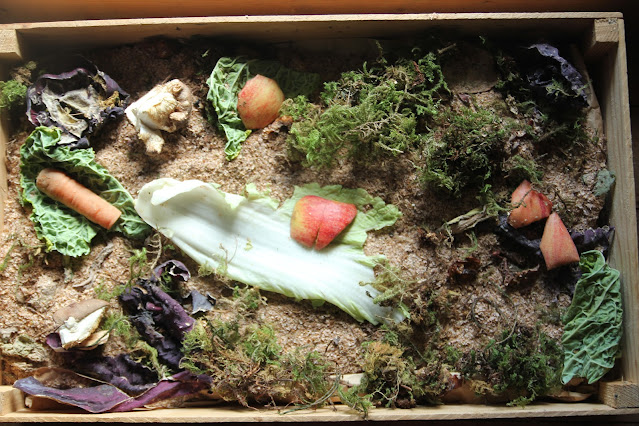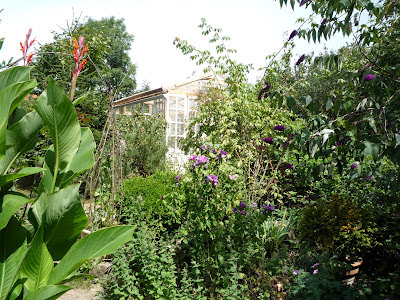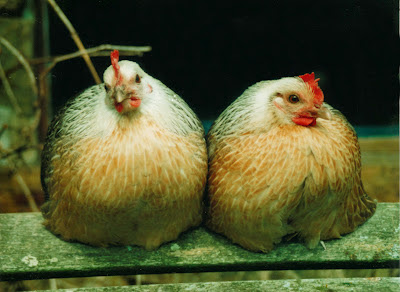This is Polly, a rare-breed, organic Ardenner bantam and one of her brood of newly hatched quail. I first started raising quail when we came to live permanently in France some fourteen years ago now.
Quail Fever - We cured the hay fever and eczema but not our addiction to raising quail
My husband Andy had suffered from hay fever every year since the Summer of 1976. We knew that coming to live a new life in an abandoned field and orchard, would be untenable unless we found a cure. We had already began extensive plantings of so many shrubs, trees and flowers, for our eventual food forest.
Furthermore, in 1977 Andy had also worked on a machine, using an oil which had caused him to have a contact dermatitis which led on to eczema.

I had read that as early as the twelfth century in Japan quail eggs were being used in the treatment of various respiratory diseases and allergies. They were also used in traditional medicine in China. We couldn't find any organic eggs so I decided I would have to raise the quail myself.
My first hens, a pair of Ardenner bantams called Chicklette and Pouldini, had been given to us in part payment for looking after a neighbouring smallholding whilst the owners went on holiday. Our Ardenners seemed ideal for the job, they were excellent mothers, foragers, they trusted us and they were very quick in everything they did, a great advantage with precocious quail.
Why we all need to give quail a better deal in life

Whilst waiting to get my eggs I bought five quail from a livestock market in a nearby town. It was not initially a happy experience, the quail were totally neurotic when I bought them and equally so in the outside run we had made them. Luckily I had heeded the warnings and made a run with a soft voile top, as at the slightest noise they launched themselves up into the air. Over time however, they became accustomed to their environment, calmed down and began to lay. The one thing we used to love to do was to sit and watch them come out of their little house every morning with a hop-skip-jump and a beat of the wings, full of the
joie de vivre. On visiting several places where they raised quail, I soon realised the key to their whole behaviour patterns. Everywhere we went quail were raised inside, on wire, mostly in artificial light and caged with hardly room to move. They were in effect laying machines, fed a high protein grain-based and sometimes medicated feed and with no greenery and certainly with no ghost of an attempt at their natural insectivore diet.
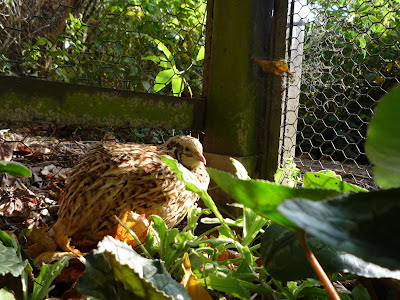
This is Golden Grandma out taking the sun in the little enclosed garden in front of the Bake House. She is four years old, having spent three and a half years with us as part of the flock. I'm happy to say she enjoyed life though she was never quite as tame as any of our home-raised birds. She was the last quail I ever bought, my own quail having succumbed to a rat attack that same year. I lost the whole flock including our much-loved Flopsy a five year-old 'English white' quail, who would follow me around the garden as long as I had a fork in my hand. GG, when we bought her, was 'living' caged in a garage, most of the other birds with her looked terrible and all showed signs of injury. They had obviously been fighting, I should have just turned away and left but I couldn't, I bought five females in all and this little golden quail was the only one who survived past the first week. The man I bought her from invited us to view his 'exhibition hens', they at least, were out in the open air. I could not comprehend how he could not see what he was doing was morally wrong. Unfortunately he is not the worst. I know of hunters who train their dogs by tying a quail by the leg to a stick in a field and then letting the dog loose to find it. When I remonstrate, I am always told that the dog knows never to touch the quail. There is a mental block with some humans in understanding that birds are sentient beings. They would do well to heed Gandhi's words; "The greatness of a nation and its moral progress can be judged by the way in which its animals are treated".'
My First Hatch of Quail Eggs
The hatching of my first ever quail with Chicklette was rather traumatic. I had obtained eggs from two colours of quail 'Isabelle' or 'Gold', (see Granny above) and 'Range' a dark chocolate brown. Something I hadn't considered but which soon became apparent and was to affect the hatch, was that my Ardenner Mother had a total aversion to mice. In the main most hens love mice, to eat that is. I was right on hand when the quail started to hatch and we were probably more excited than the hen was.

The problems started when Chicklette decided to take a good look at the babies, probably because they were making unusual (non-chick) noises and possibly because they smell different. Normally because she is at her most vulnerable, a Mother hen clamps down upon her chicks as they hatch, making encouraging noises in a low voice, something which would get no response with quail. It is true that some hens reach under and eat the shells as the chicks emerge and thereby remove the evidence of hatching which might attract predators. However, Chicklette took one look at these quail chicks and suddenly they were flying though the air and I could see she was only throwing out the chocolate coloured ones, which looked uncannily like mice. I gathered them all up and presented them individually, showing her that they were indeed baby birds, and happily she accepted them all back under her wings.

This is Poulie with a hatch of Crested Polish Chicks, she too was a wonderful caring parent. If you are thinking of going ahead and raising quail always chose a Mother hen who has a good track record with raising chicks. Quail need a mother hen who has an excellent understanding of and is quick to notice changes in behaviour. Some mothers are very good at finding food but a quail 'mother' needs to be equally good at recognising the moment the quail need to go back under her for warmth and rest. She needs to stop foraging and 'sit', not all hens are good at this. Cold baby quail make a lot of strange almost whining noises, which can be very disconcerting, a good mother hen responds to this immediately. She will also be the first to notice any nutrient deficiencies, very common in quail from non-organic hatching eggs. If you see her pushing Baby back up on its feet, then be aware she has noticed it sitting down too long. This is the first sign of a Vitamin B and/or selenium deficiency and is very common in domesticated game birds and hence in their eggs. A good mother hen will be watching for this problem in baby chicks because it is one of the more common signs and in fact part of a natural remedy for coccidiosis, that is to keep the baby bird moving and expel the problem.
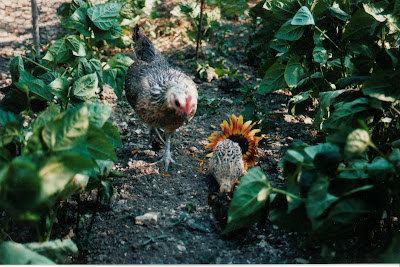
Despite the initial trauma at hatching, Chicklette went on to form a strong bond with the quail, which allowed her to free-range them in the garden, doing sterling work amongst the bean rows. She stayed with them as their Mother for quite some time, longer than I had expected, I think the size of them fooled her into thinking they were still small chicks, who needed care.
Having cured the hay fever and eczema what next? The symbiosis continues in the Garden.

After eating those few eggs from our first quail, all those years ago, Andy never developed hay fever. In fact he never had hay fever ever again, nor interestingly enough eczema. Five years ago the nature of the active enzyme, the trypsin inhibitor which effects the cure was finally identified and pills made of quail eggs may now be purchased at organic stores. We certainly owe our quail a debt of gratitude.
When my quail eggs hatched last March I had the luck to film the quail chicks as they emerged and I went on to document their first few days of life with Polly, daughter of Chicklette. In my next Quail Post I will take you through the joys and pitfalls of those first few days, culminating in the quail's first foray into the Greenhouse and the start of their full-time job in keeping down the greenfly, whitefly, black fly and any other nuisances they can help us with.
Thanks for dropping by and do feel free to share experiences or ask for further information in the comment section. If you have enjoyed this piece and found it useful think about sharing it with your family and friends, on social media and also maybe about joining this blog and/or subscribing to my Youtube, Odysee or BitChute Channel or even supporting us on Patreon or
It all helps to keep me going!
Until next time, all the very best from sunny Normandie!
Sue
Part Two of my series on Hatching and Raising Quail organically can be found:
here
RELATED ARTICLES
Taking you through the first few days.
Polly
and the quail at three days old and already something of a handful! I
kept them in the nest for the first three days, letting them gain in
strength...
read more
 How your hen can bring out the best in baby quail.
How your hen can bring out the best in baby quail.
Years
of selective breeding have not only bred the broodiness out of
domesticated quail but also their ability to identify and seek out their
own food.
read more
 A comprehensive guide into the history & use of quail eggs in medicine Part 1
A comprehensive guide into the history & use of quail eggs in medicine Part 1
How we cured Andy's hay fever and eczema with a dip into Ancient Egypt and 60's France...
read more
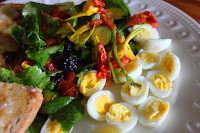 A comprehensive guide into the history & use of quail eggs in medicine Part 2
A comprehensive guide into the history & use of quail eggs in medicine Part 2
Now
we eat quail eggs for pleasure..here I look in depth at the clinical
trials in the 1960s and the posology used then and by us...
read more


